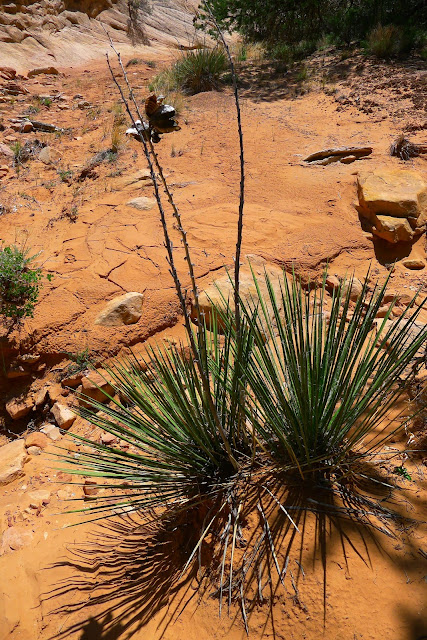As mentioned before, part of my duties as a volunteer is to patrol the trails. Yesterday Laura and I did on a fast and furious loop hike down Bullet Canyon to Grand Gulch and then up Sheik’s Canyon to the park truck sitting at the trailhead – a distance of roughly ten rough miles. Ostensibly our job was to check on the ruins and water sources and interact with visitors, if any.
Hiking west on an old abandoned jeep trail – that had been bulldozed in to look for uranium back in the 50’s – we dropped over the rimrock into Bullet and made our way down the slickrock.
The first order of business was to check on a well-known ruin named Perfect Kiva. (Yes…another perfect kiva; different from the one in Slickhorn Canyon I wrote about in a previous post.) Stabilized years ago by the park service to accommodate visitor usage, we checked for abuse (none) and then chatted up the folks that were there. They had a lot of questions about who, what, when, etc. One woman wanted to know what they used to make their paint for the pictographs? (crushed minerals and plants mixed with grease) while another asked about the closet water source? (just around the corner)
Since we had miles to go before sundown, we wished them well, said our goodbyes and headed down canyon to inspect Jailhouse Ruin, its spring and then on to the junction two miles later with Grand Gulch.
One of the great things about hiking with someone who’s been here over twenty-five years like Laura, is that she knows exactly where all the ‘goodies’ are - this saves one lots of time bashing through the brush wasting energy searching for sites in vain. Keeping an eye on the sun and watching the shadows lengthen, we boogied along visiting Castle Ruin, Rincon Ruin and numerous rock art panels most don’t know about and certainly aren't found on any map.
Late in the afternoon we turned east up Sheik’s Canyon and stopped for a welcome water break at Green Mask panel. This is a very unusual panel in that almost all the pictographs are of women.
Laura noted that a mummy of a ‘princess’ had been discovered here many years ago and the speculation was that this alcove was a sort of ritualized tomb for her. After taking a passle of photos and admiring the work, we headed up canyon and began a long, dusty scramble up a scree slope to a higher slickrock bench that eventually led us out of the canyon and back to our starting point.
Five major ruins, over twenty rock art panels and ten, rocky canyon miles – all done in seven hours. Woof! I’m not ashamed to admit I was pooped. The hot shower that night surely was well-deserved.

.JPG)
.JPG)






.JPG)
.JPG)











.JPG)

.jpg)




